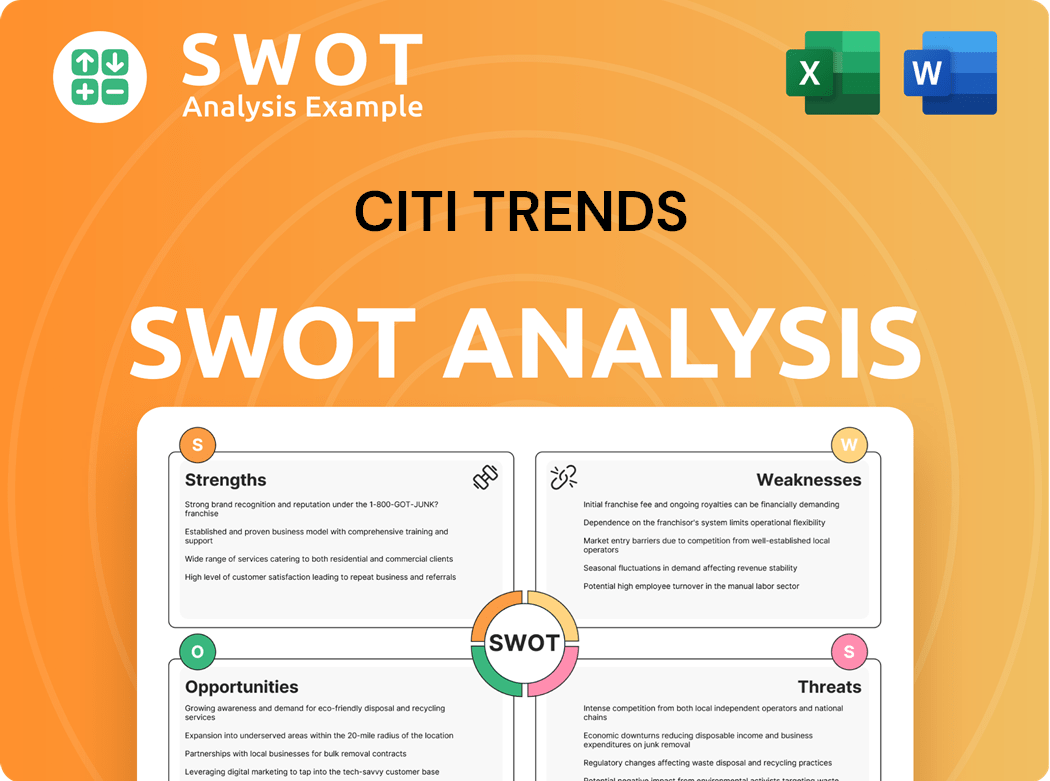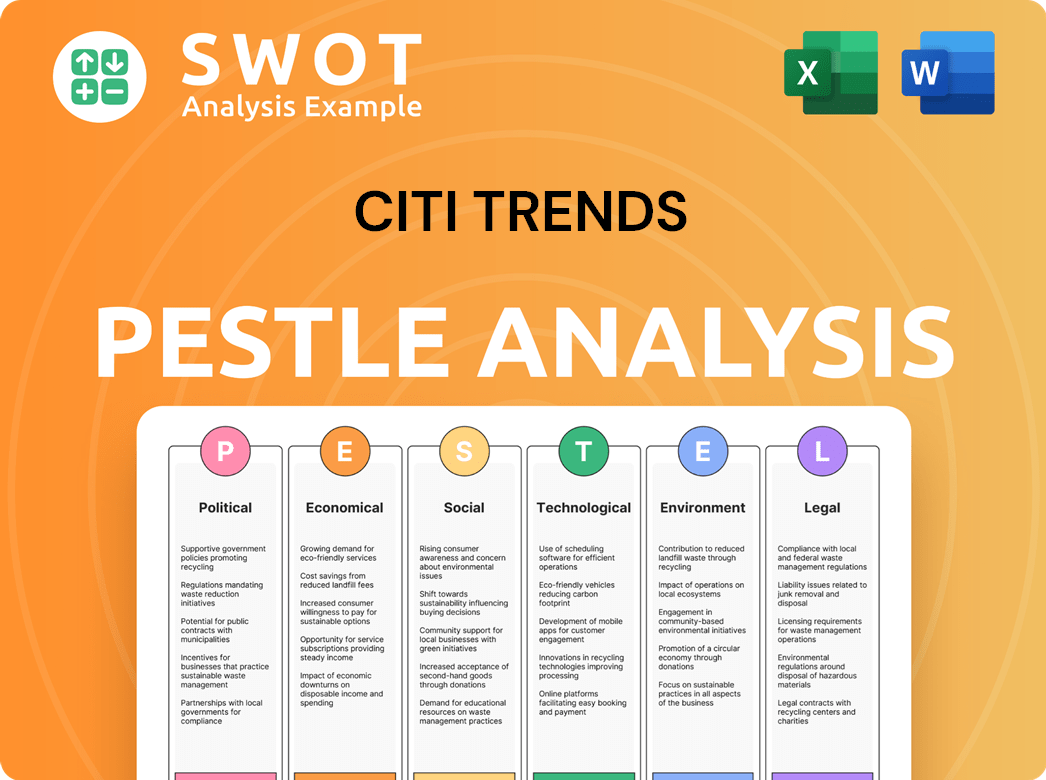Citi Trends Bundle
How Does Citi Trends Thrive in a Crowded Retail World?
The discount retail industry is a battlefield, and understanding the Citi Trends SWOT Analysis is crucial to navigating its complexities. With consumer preferences constantly evolving and competition fierce, how does Citi Trends maintain its position? This analysis dives into the company's competitive landscape, dissecting its strengths, weaknesses, opportunities, and threats.

This exploration of the Citi Trends competitive landscape will reveal its key competitors, market share dynamics, and strategic advantages. We'll examine the value fashion stores and the apparel retail market to provide a comprehensive market analysis. Furthermore, this analysis will answer critical questions like: Who are Citi Trends' main rivals, and how does Citi Trends' business model analysis contribute to its success?
Where Does Citi Trends’ Stand in the Current Market?
Citi Trends carves out a specific niche within the discount retail industry, concentrating on value-priced apparel and home décor, especially for urban markets. The company's business model centers on providing budget-friendly fashion and home goods to a customer base in underserved communities. As of early 2024, Citi Trends operated around 600 stores across 33 states, showcasing a significant physical presence.
The value proposition of Citi Trends is built on affordability, with a focus on offering discounted prices on a variety of products. Its core offerings include apparel for men, women, and children, alongside shoes, accessories, and home goods. This strategy has allowed Citi Trends to maintain a strong market position within the value fashion stores segment.
Citi Trends is a leading player in the value-priced retail sector, specializing in urban fashion and home décor. Its primary focus is on providing affordable products to budget-conscious consumers, particularly in urban and underserved areas across the United States. The company's extensive store network and product offerings reflect its commitment to this market segment.
Citi Trends' strengths include its focus on value, efficient inventory management, and strong vendor relationships, which enable competitive pricing. The company also benefits from a significant presence in the Southeastern and Southern United States. These factors contribute to its ability to maintain a loyal customer base and navigate the competitive landscape.
For fiscal year 2023, Citi Trends reported total sales of $782.9 million. Despite a slight decrease from the previous year, the company demonstrated profitability, with a net income of $5.7 million. This financial performance highlights the company's resilience and effective cost management within the apparel retail market.
Citi Trends has historically prioritized its core demographic and value proposition, avoiding shifts into premium markets. The company has also enhanced its e-commerce capabilities to reach a broader online audience. Its strategic focus on affordability and operational efficiency contributes to its continued success in the discount retail industry.
Citi Trends' market position is influenced by several key factors, including its target audience, geographic concentration, and product offerings. The company's ability to efficiently manage inventory and maintain strong vendor relationships is crucial for its competitive pricing strategy. Understanding the competitive landscape of Citi Trends is essential for assessing its long-term prospects.
- Focus on value-priced apparel and home décor.
- Strong presence in urban and underserved communities.
- Emphasis on efficient inventory turnover.
- Enhancement of e-commerce capabilities.
Citi Trends SWOT Analysis
- Complete SWOT Breakdown
- Fully Customizable
- Editable in Excel & Word
- Professional Formatting
- Investor-Ready Format

Who Are the Main Competitors Challenging Citi Trends?
The Citi Trends competitive landscape is shaped by a diverse array of retailers, all vying for the attention of budget-conscious consumers. This analysis is crucial for understanding the company's position within the discount retail industry and its ability to compete effectively. Understanding who Citi Trends' main rivals are and how they operate is key to strategic planning.
Citi Trends' market analysis reveals a dynamic environment where both direct and indirect competitors impact its performance. The company's ability to maintain its market share and grow depends on its response to competitive pressures. This includes adapting to changing consumer preferences and leveraging its strengths in the apparel retail market.
Direct competitors are those that offer similar products and target the same customer base. These retailers directly challenge Citi Trends' market share.
Indirect competitors offer different products or operate in different segments, but still appeal to the same target audience. These competitors can impact Citi Trends' sales.
Understanding the competitive advantages of Citi Trends is essential for evaluating its long-term prospects. This includes its store locations and expansion strategies.
Analyzing Citi Trends' market share compared to competitors provides insights into its relative position in the market. This analysis helps to gauge its overall performance.
Comparing Citi Trends' financial performance vs competitors helps to assess its financial health and strategic effectiveness. This includes evaluating its growth strategies.
A Citi Trends' business model analysis is crucial for understanding its operations and strategic positioning. This includes examining its product offerings and pricing.
Citi Trends competitors include a mix of off-price retailers, fast-fashion brands, and mass merchandisers. Value fashion stores like Burlington Stores, Ross Stores, and TJX Companies (T.J. Maxx and Marshalls) are direct competitors, offering similar product assortments at discounted prices. Online retailers like Shein and Temu represent indirect competition, focusing on fast fashion and low prices. Mass merchandisers such as Walmart and Target also compete by offering apparel at competitive prices. For a deeper dive into the company's ownership structure, you can read more at Owners & Shareholders of Citi Trends.
The competitive landscape is dynamic, with each competitor employing different strategies to attract customers. Analyzing these strategies is crucial for understanding Citi Trends' growth strategies.
- Burlington Stores: Operates large stores with a broad selection of apparel, home goods, and accessories. Focuses on offering a wide variety of brands at discounted prices.
- Ross Stores: Known for its off-price model, with a strong national presence and frequent new arrivals. Competes on price and brand variety.
- TJX Companies (T.J. Maxx and Marshalls): Offers designer and brand-name merchandise at reduced prices. Focuses on a constantly changing inventory and a treasure-hunt shopping experience.
- Shein and Temu: These online retailers offer a vast selection of trendy apparel at very low prices. They compete on price and the rapid introduction of new styles.
- Walmart and Target: Offer extensive clothing departments with competitive pricing. They leverage their large store footprints and broad product offerings to attract customers.
Citi Trends PESTLE Analysis
- Covers All 6 PESTLE Categories
- No Research Needed – Save Hours of Work
- Built by Experts, Trusted by Consultants
- Instant Download, Ready to Use
- 100% Editable, Fully Customizable

What Gives Citi Trends a Competitive Edge Over Its Rivals?
Analyzing the Growth Strategy of Citi Trends involves understanding its competitive advantages within the discount retail industry. The company has carved a niche by focusing on the urban and underserved customer demographic, tailoring its merchandise to resonate with their preferences. This targeted approach is a key differentiator in the apparel retail market, allowing it to build strong customer loyalty.
A crucial aspect of Citi Trends' success is its efficient supply chain and opportunistic buying strategy. By sourcing branded and private label merchandise at discounted prices, the company can offer compelling value to its customers. This strategy, combined with a flexible buying model, enables it to adapt quickly to changing fashion trends and inventory availability, which is essential in the value fashion stores sector.
Citi Trends' extensive brick-and-mortar presence, particularly in underserved neighborhoods, provides convenient access for its core customer base. This physical footprint supports a well-established operational model, creating economies of scale in distribution and store operations. While the company has invested in its e-commerce platform to enhance its omnichannel capabilities, its core strength remains in its physical stores.
Citi Trends excels by concentrating on the urban and underserved demographic. This specialization allows for a merchandise assortment that aligns with the fashion preferences and cultural nuances of its target market. This localized approach fosters strong customer loyalty and repeat business, distinguishing it from broader retail chains.
The company's efficient supply chain and opportunistic buying strategy are significant advantages. Citi Trends sources branded and private label merchandise at substantial discounts, often through closeouts and overruns. This enables the company to offer competitive pricing, a key differentiator in the value segment.
Citi Trends strategically places its stores in neighborhoods often underserved by larger retailers. This physical presence provides convenient access for its core customer base. The well-established operational model for managing a large store network supports economies of scale in distribution and store operations.
Citi Trends' flexible buying model allows for quick adaptation to changing fashion trends and inventory availability. This agility enables the company to stay current with consumer preferences and maintain a fresh product mix, a critical factor in the fast-paced apparel retail market.
Citi Trends' competitive advantages include its targeted customer focus, efficient supply chain, strategic store locations, and adaptable buying model. These elements collectively contribute to its ability to offer value and maintain a strong market position.
- Focus on the urban and underserved customer demographic.
- Efficient sourcing of discounted merchandise.
- Strategic placement of stores in underserved areas.
- Adaptable buying strategies to meet changing trends.
Citi Trends Business Model Canvas
- Complete 9-Block Business Model Canvas
- Effortlessly Communicate Your Business Strategy
- Investor-Ready BMC Format
- 100% Editable and Customizable
- Clear and Structured Layout

What Industry Trends Are Reshaping Citi Trends’s Competitive Landscape?
The Citi Trends competitive landscape is significantly influenced by the dynamic nature of the discount retail industry. The company operates within the apparel retail market, facing competition from various players. Understanding the Citi Trends competitors and their strategies is crucial for assessing its market position and future prospects. The company's value fashion stores model caters to a specific demographic, making its competitive analysis complex.
The retail sector is undergoing significant transformations. The rise of e-commerce and omnichannel retailing, coupled with the influence of fast fashion, are key industry trends. These factors present both challenges and opportunities for companies like Citi Trends, impacting their strategies and market share. The competitive environment requires continuous adaptation to maintain a strong foothold in the market.
E-commerce and omnichannel retailing are growing, requiring seamless online and offline experiences. Fast fashion and ultra-low-cost online retailers create pricing pressure. Companies must respond quickly to changing fashion trends and consumer preferences.
Inventory management in volatile supply chains is a key challenge. Inflationary pressures impact operational costs and consumer spending. Intense competition from discount retailers and online newcomers persists. Attracting and retaining a skilled workforce is also a concern.
Leveraging brand recognition and customer loyalty can drive expansion into new product categories. Optimizing the supply chain through data analytics can improve efficiency. Strategic partnerships with emerging brands can refresh merchandise offerings. Community presence offers localized marketing and engagement opportunities.
Citi Trends is focused on improving comparable store sales and profitability. This involves optimizing inventory, enhancing customer experience, and controlling expenses. Adapting to trends, investing in digital capabilities, and refining merchandising are crucial.
To maintain its competitive edge, Citi Trends must leverage its strengths. The company's established brand recognition and loyal customer base within its niche market are significant assets. Further optimizing its supply chain and enhancing its digital presence are essential for future success.
- Strong brand recognition and customer loyalty.
- Focus on value-conscious urban consumers.
- Strategic store locations.
- Adaptability to market trends.
Citi Trends Porter's Five Forces Analysis
- Covers All 5 Competitive Forces in Detail
- Structured for Consultants, Students, and Founders
- 100% Editable in Microsoft Word & Excel
- Instant Digital Download – Use Immediately
- Compatible with Mac & PC – Fully Unlocked

Related Blogs
- What are Mission Vision & Core Values of Citi Trends Company?
- What is Growth Strategy and Future Prospects of Citi Trends Company?
- How Does Citi Trends Company Work?
- What is Sales and Marketing Strategy of Citi Trends Company?
- What is Brief History of Citi Trends Company?
- Who Owns Citi Trends Company?
- What is Customer Demographics and Target Market of Citi Trends Company?
Disclaimer
All information, articles, and product details provided on this website are for general informational and educational purposes only. We do not claim any ownership over, nor do we intend to infringe upon, any trademarks, copyrights, logos, brand names, or other intellectual property mentioned or depicted on this site. Such intellectual property remains the property of its respective owners, and any references here are made solely for identification or informational purposes, without implying any affiliation, endorsement, or partnership.
We make no representations or warranties, express or implied, regarding the accuracy, completeness, or suitability of any content or products presented. Nothing on this website should be construed as legal, tax, investment, financial, medical, or other professional advice. In addition, no part of this site—including articles or product references—constitutes a solicitation, recommendation, endorsement, advertisement, or offer to buy or sell any securities, franchises, or other financial instruments, particularly in jurisdictions where such activity would be unlawful.
All content is of a general nature and may not address the specific circumstances of any individual or entity. It is not a substitute for professional advice or services. Any actions you take based on the information provided here are strictly at your own risk. You accept full responsibility for any decisions or outcomes arising from your use of this website and agree to release us from any liability in connection with your use of, or reliance upon, the content or products found herein.